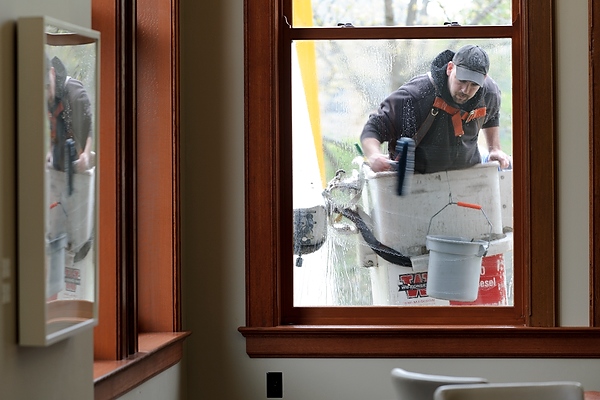Window washers bring a shine back to campus buildings

Working with the aid of a bucket-truck lift, Rich Neustadter, a facilities repair worker with Campus Services, washes exterior windows at the Education Building at the University of Wisconsin–Madison during spring on April 18, 2012. The photograph was created for #UWRightNow, a 24-hour multimedia and social network project.
Photo: Jeff Miller
From the inside of each campus building, most people probably see out of a few windows each day. The condition of those windows makes a huge difference in the way they see the world.
Bascom Hall, for example, boasts a stately multistory façade dating back from the mid-19th century. The shape and molding of the windows enhance the building’s historic character; some of its windows have up to 12 panes apiece.
That charming façade features over 450 windows – and someone has to clean them all.
Campus Services is the University of Wisconsin–Madison’s go-to crew for odd jobs. The same people who manage interdepartmental mail delivery and move furniture also clean nearly every window across campus.
How many windows is that, exactly?
Thousands, says Dave Grueneberg, supervisor of Campus Services.
Cleanings take place in all types of weather. Five guys take window-washing duty on each side of campus, fitting in cleanings around duties such as changing lightbulbs and hauling supplies for tradesmen.
On this day, the east side crew arrives fresh off of work at the Extension Building, on Lake St. Given their other responsibilities, they estimate that the job will take them about a month.
Budget cuts over the last decade have extended the cleaning schedule to a seven-year rotation; however, departments hoping to decrease the gap can pay for more frequent touchups.
The variety of building on campus poses multiple challenges. Individual panes on hundred-year-old windows take more time than the wide expanses of glass on more modern buildings. Five-piece storm windows with ancient clamps can drop on workers without warning. Air conditioners, metal grates, concrete window wells and flaking paint can complicate each job even more.
In the past, many taller buildings, such as Van Hise Hall and Educational Sciences, had spinnable windows that allowed the cleaners to work from the inside. But deteriorating mechanisms and permanent –screwed-in – storm windows mean that now the cleaners must use a bosun’s chair or suspended stage.
Regardless of height, the basic tools are a wand, water and squeegee. Extended handles and scrubbing pads are necessary on tough spots, covered in bug residue and cobwebs.
“We’re all pretty set on the tools we like to use. I like the wand,” says Rick Neustadter, who also professes a love for the drivable lift.
“Don’t lie!” laughs Stan Gudgel, whom Neustadter calls Gudgel the “master of the electric chair.” (Ben Olson, one of the crew’s senior members, likes ladder work.)
Other buildings aren’t quite as tall, but offer unexpected obstacles thanks to architectural whims. The newest tower of the Chemistry Building has a stage setup for cleaning its glass face, but varied rooflines prevent it from moving to another side. Helen C. White’s overhangs prevent top-down access.
Helen C. White, among other campus buildings, also suffers from heavy etching. Water runs off of the concrete block, depositing lime residue on the glass. It won’t come off without an acid, which is caustic for the workers and damages the frame, so they typically do their best with normal tools.
Given construction, safety upgrades and a seven-year cycle between cleanings, every job is new. The men give great credit to Grueneberg, their supervisor, for keeping safety first, inspecting the equipment regularly and not sending the crews to do anything he wouldn’t do himself.
“They’ve probably done some windows three or four ways,” says Olson. “Birge had these old hooks; people used to climb out the window onto a little parapet, hook a belt around them and lean back.”
Figuring out the logistics can take more time than the cleaning itself. When it happens, though, the difference is clear. The people on the inside get more light and a new perspective on the world outside.
Over two weeks last fall, Terri Wipperfurth and her colleagues got to know the men who made her building sparkle again. Alternating window washing with the never-ending cycle of other campus responsibilities, the crew returned day after day until the job was done.
“They came in with such a good attitude and did the job to the best of their ability,” says Wipperfurth, department administrator for Agricultural and Applied Economics. “The folks at Taylor Hall were better able to enjoy the beautiful fall color thanks to Jerry Meise and his crew of window washers – Dan Reed, Melroy Schlueter, Rob Keiser, and Mark Walker. We really appreciated them.”
The window washers have developed their techniques to a T, leaving even their own bathroom mirrors pristine. They don’t hesitate to share their knowledge.
“Tell everybody, ‘Don’t use Windex,’” says Neustadter. “Leaves a film on the windows.”
“People always say, ‘If I try to do the windows, why are they all smudgy?’” says Olson. “You have to use a squeegee, or else it’ll be smudged – that’s just the way it is.”
Tags: campus
